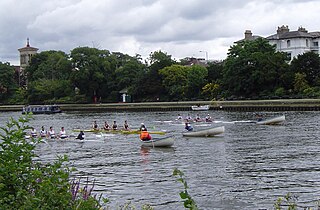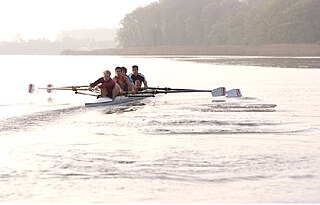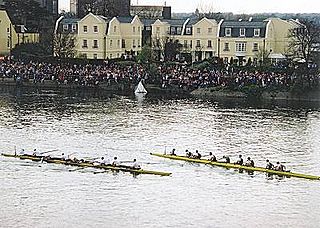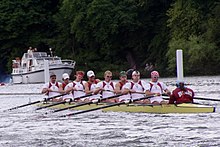
Rowing, often called crew in the United States, is the sport of racing boats using oars. It differs from paddling sports in that rowing oars are attached to the boat using rowlocks, while paddles are not connected to the boat. Rowing is divided into two disciplines: sculling and sweep rowing. In sculling, each rower holds two oars, one in each hand, while in sweep rowing each rower holds one oar with both hands. There are several boat classes in which athletes may compete, ranging from single sculls, occupied by one person, to shells with eight rowers and a coxswain, called eights. There are a wide variety of course types and formats of racing, but most elite and championship level racing is conducted on calm water courses 2 kilometres (1.2 mi) long with several lanes marked using buoys.
Fibre-reinforced plastic is a composite material made of a polymer matrix reinforced with fibres. The fibres are usually glass, carbon, aramid, or basalt. Rarely, other fibres such as paper, wood, boron, or asbestos have been used. The polymer is usually an epoxy, vinyl ester, or polyester thermosetting plastic, though phenol formaldehyde resins are still in use.

In watercraft, a racing shell is an extremely narrow, and often comparatively long, rowing boat specifically designed for racing or exercise. It is equipped with long oars, outriggers to hold the oarlocks away from the boat, and sliding seats. The boat's long length and semicircular cross-section reduce drag to a minimum. This makes the boat both fast and unstable. It must be balanced by the rowers to avoid tipping. Being able to balance – or "set" – the boat while putting maximum effort into the oars is therefore an essential skill of sport rowing.

Vespoli USA is a manufacturer of rowing shells. It was founded by former Georgetown University rower and Olympian Mike Vespoli in 1980.

Sykes Racing is an Australian manufacturer of rowing shells. The boats are widely popular by Australian rowers from schools through to Olympians.

The A-Class Catamaran, often abbreviated to A-Cat, is a development class sailing catamaran for singlehanded racing.

Filippi Boats is an international manufacturer of rowing racing shells based in Italy. The company was founded in 1980 by Lido Filippi.

Janousek Racing Boats Ltd is a British-based manufacturer of rowing boats / racing shells established in 1981 by Bohumil Janoušek, a Czech rower and Olympic double bronze medallist.

A coxless pair, abbreviated as a 2- and also known as a straight pair, is a racing shell used in the sport of competitive rowing. It is designed for two rowers, who propel the boat with sweep oars.

A single scull, abbreviated as a 1x, is a racing shell designed for a single person who propels the boat with two oars, one in each hand.

Spray-Up also known as chop method of creating fiberglass objects by spraying short strands of glass out of a pneumatic gun. This method is used often when one side of the finished product is not seen, or when large quantities of a product must be made cheaply and quickly with moderate strength requirements. Corvette fenders and boat dinghies are commonly manufactured this way.

A double scull, also abbreviated as a 2x, is a rowing boat used in the sport of competitive rowing. It is designed for two persons who propel the boat by sculling with two oars each, one in each hand.

A quadruple sculling boat, often simply called a quad and abbreviated as a 4x, is a racing shell used in the sport of competitive rowing. It is designed for four people who propel the boat by sculling with two oars, or "sculls", one in each hand.

A coxed four, abbreviated as a 4+, is a racing shell used in the sport of competitive rowing. It is designed for four persons who propel the boat with sweep oars and is steered by a coxswain.

A coxless four, abbreviated as a 4- and also called a straight four, is a racing shell used in the sport of competitive rowing. It is designed for four persons who propel the boat with sweep oars, without a coxswain.

A coxed pair, abbreviated as a 2+, is a racing shell used in the sport of competitive rowing. It is designed for two persons who propel the boat with sweep oars and is steered by a coxswain (cox).

An eight, abbreviated as an 8+, is a racing shell used in competitive rowing (crew). It is designed for eight rowers, who propel the boat with sweep oars, and is steered by a coxswain, or "cox".

An octuple sculling shell, often simply called an oct and abbreviated as an 8x or 8x+, is a racing shell used in the sport of rowing.
The Flying Phantom Elite is a French hydrofoil catamaran sailing dinghy that was designed by Martin Fischer and draws on the work of Alex Udin, Franck Cammas and the Groupama sailing team. It is intended as a one-design racer and was first built in 2015.

The Nacra 20 is a catamaran sailing dinghy that was designed by Gino Morrelli and Pete Melvin as a one-design racer and first built in 1998.

















